Groundwater research Nica style
 WHO: Essa (aka Vanessa)
WHO: Essa (aka Vanessa)WHAT: Peace Corps, Environmental Education
WHERE: Nicaragua
WHEN: Sept '05 - Nov '07
WHY: To get some sort of master´s degree out of this gig...
My entries may have been a bit lacking in substance lately, but not because I haven't been doing anything. It was finally time to put my 6-month-in-the-making master's thesis project plan (officially titled, "A pump test method for rope pump wells to forecast seasonal changes in yields") in action. I've spent the last few months meeting the folks in the community where I was planning to do my thesis project, doing surveys, sitting wells, doing lots of calculatin' and figgeren', and outfitting wells so that the tests can be performed without damaging the wells or leaving the well users without water during the tests. This entry shows the process I went through to get things set up and a bit of how the pump tests have gone thus far.
Without getting to deep in details, the idea was basically to do a series of pump tests (evacuating the well to measure recovery, or how long the well takes to fill up again) on rope pump wells. This information can be used to determine well productivity, which may change during the course of the dry season, as the water table drops since it's not being recharged by rain. The wells are simple and widespread across rural areas of Nicaragua and Central America. The pump mechanism looks like this:
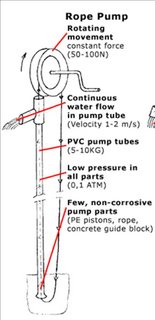 So after figuring out how much water I would extract each day from the well, I had to have a place to store the water so that it would not go to waste, as well users rarely use hundreds of gallons at a time. I bought 290 gallon storage tanks for each well I was testing. The stars were aligned in my favor the day I planned to do the tank and pipe installations, as all the materials I had ordered were in (minus a few trivial things), the technician from the water utility, Eduardo, showed on time, and transportation was not too difficult to locate. Here some of the workers are placing cement blocks upon which sits the tank.
So after figuring out how much water I would extract each day from the well, I had to have a place to store the water so that it would not go to waste, as well users rarely use hundreds of gallons at a time. I bought 290 gallon storage tanks for each well I was testing. The stars were aligned in my favor the day I planned to do the tank and pipe installations, as all the materials I had ordered were in (minus a few trivial things), the technician from the water utility, Eduardo, showed on time, and transportation was not too difficult to locate. Here some of the workers are placing cement blocks upon which sits the tank.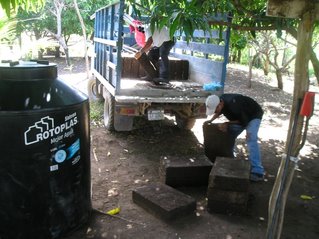 After the tank was set up, Eduardo wanted to see if we could run electricity for the drill out to the well from the nearest house. So he set up this amazingly precarious contraption to try and splice the wires. I told him I didn't want to spend my grant money paying off his hospital bills.
After the tank was set up, Eduardo wanted to see if we could run electricity for the drill out to the well from the nearest house. So he set up this amazingly precarious contraption to try and splice the wires. I told him I didn't want to spend my grant money paying off his hospital bills. Having failed at that (not because he fell, the line was dead), we resorted to the hand drill, with the help of the well owner, Don Esevio.
Having failed at that (not because he fell, the line was dead), we resorted to the hand drill, with the help of the well owner, Don Esevio. We ran about 60 feet of PVC pipe into the well, to ensure that the probe used to measure the depth to water would not get entagled in the ropes. To finish up, I can't remember what Eduardo's doing here...christening by fire...or a bit of witchcraft??
We ran about 60 feet of PVC pipe into the well, to ensure that the probe used to measure the depth to water would not get entagled in the ropes. To finish up, I can't remember what Eduardo's doing here...christening by fire...or a bit of witchcraft??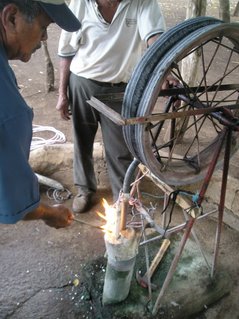 The first well was an adrenaline pumping event- at least for me as I saw my months of preparing unraveling before my eyes as we found roots had penetrated the well and almost prevented us from being able to push the PVC down as far as it needed to go. But, Eduardo persevered (I tipped him amply).
The first well was an adrenaline pumping event- at least for me as I saw my months of preparing unraveling before my eyes as we found roots had penetrated the well and almost prevented us from being able to push the PVC down as far as it needed to go. But, Eduardo persevered (I tipped him amply).Taking a break from the excitement, I made some bread with the Isabel, Maria, and Maruca:
 We installed pipe in four different wells, this one serving the local chapel. We had to supspend work as we were within a hairs breadth of getting shocked by lightning.
We installed pipe in four different wells, this one serving the local chapel. We had to supspend work as we were within a hairs breadth of getting shocked by lightning. Eduardo, Gilberto (another well owner) and I took refuge in chapel, which was threating to float away in the deluge...water was streaming under the door on the right.
Eduardo, Gilberto (another well owner) and I took refuge in chapel, which was threating to float away in the deluge...water was streaming under the door on the right.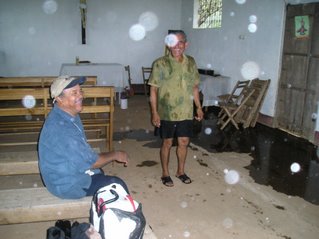 After having done a preliminary test on all the wells, I found one was too productive to measure (we couldn't pump fast enough (as the pump has a maximum rate of 5 gpm) to get the water table to drop). I was worried that this would set us back considerably, but with the help of one of the local well users and his sons (Jose, Jose Jr., and David) and their antediluvian purple beast, we were able to get to town and buy all the necessary equipment to outfit a fourth- hopefully less productive- well.
After having done a preliminary test on all the wells, I found one was too productive to measure (we couldn't pump fast enough (as the pump has a maximum rate of 5 gpm) to get the water table to drop). I was worried that this would set us back considerably, but with the help of one of the local well users and his sons (Jose, Jose Jr., and David) and their antediluvian purple beast, we were able to get to town and buy all the necessary equipment to outfit a fourth- hopefully less productive- well.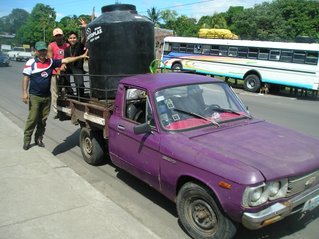 A few weeks later, John, my advisor from Michigan Tech, showed up and helped us take measurments. The two guys pumping, Jose Jr. and Alvaro, are local hires to help pump the well and dump buckets into the tank. They make the work more fun by telling jokes. I'm pretty easy to make laugh, but consternation was all I could muster after hearing this one - Q: What did one banana say to the other banana? A: We're pure potasium.
A few weeks later, John, my advisor from Michigan Tech, showed up and helped us take measurments. The two guys pumping, Jose Jr. and Alvaro, are local hires to help pump the well and dump buckets into the tank. They make the work more fun by telling jokes. I'm pretty easy to make laugh, but consternation was all I could muster after hearing this one - Q: What did one banana say to the other banana? A: We're pure potasium. Is anyone laughing?
 Noemi, another Peace Corps Volunteer, came and helped too. She quickly got bored counting buckets (the crayons were a quick easy way to keep track), so she turned it into an art of organization...
Noemi, another Peace Corps Volunteer, came and helped too. She quickly got bored counting buckets (the crayons were a quick easy way to keep track), so she turned it into an art of organization...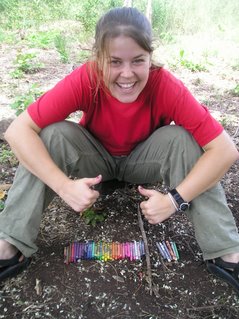 With all the Purisima activities at the chapel, we gathered quite a few spectators while doing our tests before mass:
With all the Purisima activities at the chapel, we gathered quite a few spectators while doing our tests before mass:
Below is a plot of the data we took during three pump tests on one of the wells. I'm a little disappointed that the pumping regime I had planned would not yield expected results...it won't allow me to extrapolate a trend for groundwater behavior over time. But, all is not lost, as we are still able to determine productivity and we'll just have to do pump tests over a span of months rather than days to see changes in productivity with drop in watertable. In any case, reproducibility is good!
 So, the next steps are to monitor depth to water table in the four wells, and do more pump tests over the course of the summer (until the end of August or so).
So, the next steps are to monitor depth to water table in the four wells, and do more pump tests over the course of the summer (until the end of August or so).Stay tuned for the next entry - John and I embark on a sailing adventure to the Island of Omotepe, home of two active volcanoes in the middle of Lake Nicaragua, to make some contacts for future projects...

2 Comments:
So I re-told the banana/potassium joke to my daughter (Gen) and wife (Lynn). Gen, like me, didn't see what was funny. Lynn laughed. She said that when you buy bananas now they have some sticker label that exaggerates their contents as: "pure potassium". I still don't think the joke is funny, even with this explanation. Granted I have not found many Nicaraguan jokes to be funny.
I really like your blog and have one with similar information. If you have time check it out.
The best siteGround water
Post a Comment
<< Home